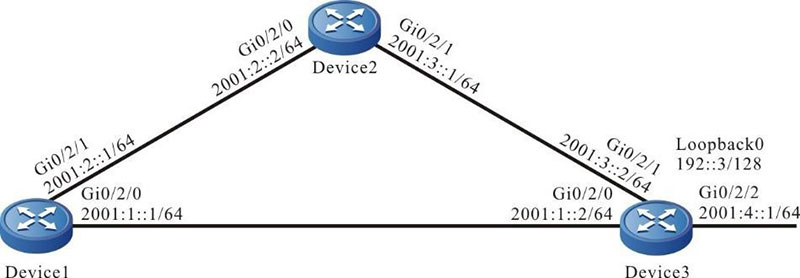Network Requirements
- On Device1, configure two static routes to the segment 192::3/128: one is reachable via Device2, and the other is reachable via Device3. Device1 first uses the line with Device3 to forward the packet.
- On Device1, configure one static recursive route to the segment 2001:4::/64, and the gateway address is the loopback interface address of Device3 192::3. After the line between Device1 and Device3 fails, the route can switch to Device2 for communication.
Network Topology

Figure 4-4 Networking for configuring IPv6 static recursive route
Configuration Steps
Step 1: Configure the IPv6 address of the interface (omitted).
Step 2: Configure the IPv6 static route.
#Configure Device1.
|
Device1#configure terminal
Device1(config)#ipv6 route 192::3/128 2001:1::2
Device1(config)#ipv6 route 192::3/128 2001:2::2 10
|
#Configure Device2.
|
Device2#configure terminal
Device2(config)#ipv6 route 192::3/128 2001:3::2
|
Step 3: Configure the IPv6 static recursive route.
# Configure Device1.
|
Device1(config)#ipv6 route 2001:4::/64 192::3
|
#Query the IPv6 route table of Device1.
Device1#show ipv6 route
Codes: C - Connected, L - Local, S - static, R - RIP, B - BGP, i-ISIS
U - Per-user Static route
O - OSPF, OE-OSPF External, M - Management
L ::1/128 [0/0]
via ::, 2w0d:03:12:46, lo0
S 192::3/128 [1/10]
via 2001:1::2, 00:04:54, gigabitethernet0/2/0
C 2001:1::/64 [0/0]
via ::, 00:22:47, gigabitethernet0/2/0
L 2001:1::1/128 [0/0]
via ::, 00:22:45, lo0 C 2001:2::/64 [0/0]
via ::, 00:16:16, gigabitethernet0/2/1
L 2001:2::1/128 [0/0]
via ::, 00:16:15, lo0
S 2001:4::/64 [1/10]
via 192::3, 00:00:43, gigabitethernet0/2/0
In the IPv6 route table, you can see that the gateway address of the route 2001:4::/64 is 192::3, the egress interface is gigabitethernet0/2/0, and the route depends on the route 192::3/128.
Step 4: Check the result.
#After the line between Device1 and Device3 fails, query the IPv6 route table of Device1.
Device1#show ipv6 route
Codes: C - Connected, L - Local, S - static, R - RIP, B - BGP, i-ISIS
U - Per-user Static route
O - OSPF, OE-OSPF External, M - Management
L ::1/128 [0/0]
via ::, 2w0d:03:17:48, lo0
S 192::3/128 [10/10]
via 2001:2::2, 00:00:06, gigabitethernet0/2/1
C 2001:2::/64 [0/0]
via ::, 00:21:18, gigabitethernet0/2/1
L 2001:2::1/128 [0/0]
via ::, 00:21:17, lo0
S 2001:4::/64 [1/10]
via 192::3, 00:00:06, gigabitethernet0/2/1
Compared with the route table of step 3, you can see that the egress interface of the route 2001:4::/64 is gigabitethernet0/2/1, indicating that the route already switches to Device2 for communication.
 Switch
Switch Wifi - Access Point
Wifi - Access Point Firewall
Firewall Router
Router Module Quang
Module Quang![Module Quang Cisco]() Module Quang Cisco
Module Quang Cisco![Module quang HPE]() Module quang HPE
Module quang HPE![Module quang Maipu]() Module quang Maipu
Module quang Maipu![Module quang Brocade]() Module quang Brocade
Module quang Brocade![Module quang Fortinet]() Module quang Fortinet
Module quang Fortinet![Module quang Aruba]() Module quang Aruba
Module quang Aruba![Module quang OEM]() Module quang OEM
Module quang OEM![Module quang Juniper]() Module quang Juniper
Module quang Juniper![Module quang Dell]() Module quang Dell
Module quang Dell![Module quang Palo Alto]() Module quang Palo Alto
Module quang Palo Alto![Module quang Huawei]() Module quang Huawei
Module quang Huawei![Module quang Arista]() Module quang Arista
Module quang Arista![Module quang F5]() Module quang F5
Module quang F5![Module quang H3C]() Module quang H3C
Module quang H3C![Module Quang Allied Telesis]() Module Quang Allied Telesis
Module Quang Allied Telesis![Module quang SonicWall]() Module quang SonicWall
Module quang SonicWall![Module quang Mikrotik]() Module quang Mikrotik
Module quang Mikrotik![Module quang Handar]() Module quang Handar
Module quang Handar Máy chủ (Server)
Máy chủ (Server) Thiết bị lưu trữ (SAN, NAS)
Thiết bị lưu trữ (SAN, NAS) Load Balancing
Load Balancing Video Conferencing
Video Conferencing Phụ kiện máy chủ
Phụ kiện máy chủ Thiết Bị IoT
Thiết Bị IoT Phụ Kiện Mạng
Phụ Kiện Mạng




.png)
























